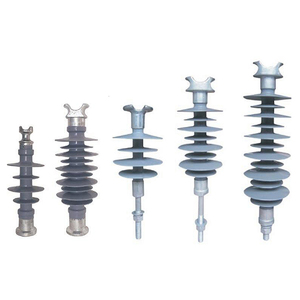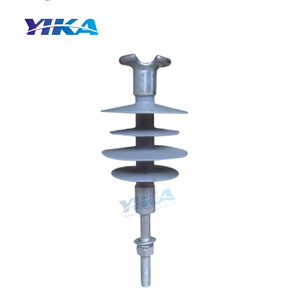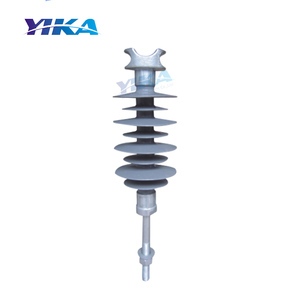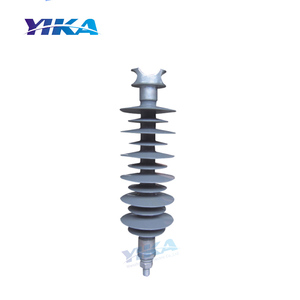(78 products available)






































































































































20 kV pin insulators come in various types for distinct installations. The following section describes these varieties in detail.
Since porcelain has excellent strength, dielectric ability, and tolerability to harsh weather, it makes an ideal material for 20 kV pin insulators. Further, the smooth surface of porcelain is essential in preventing the accumulation of pollutants on the insulator. Such a feature could potentially lead to flashovers. Also, the pin type insulators from the 20 kV range provide great mechanical strength to support power lines.
Composite pin insulators comprise a solid elastomeric insulating material over a metal core. Often, such materials include silicone rubber or other compounds with superior dielectric properties. In addition, they are lighter than porcelain insulators. This characteristic allows for simpler installation in many cases. Also, silicone rubber offers collaborative pollution and aging resistance. This feature gives it suitability in severe environmental conditions.
Manufacturers construct glass insulators from toughened glass. This material offers transparency and great electric insulation features. Also, the smooth and minimally frosted surface of glass effectively thwarts the accumulation of harmful material. This function is critical in areas susceptible to environmental contaminants. Additionally, glass pin insulators have excellent mechanical strength. This strength has made them famous for supporting overhead power lines.
As the name suggests, these pin insulators feature a rubber boot or housing type over a conductive pin. They provide added protection against environmental contaminants and electrical discharges. Commonly, manufacturers recommend these insulators for areas with extreme weather conditions. These conditions include high humidity or coastal regions where pollution levels are significant. The rubber boot helps avert flashovers, enhancing system reliability.
Different materials and compositions make 20 kV pin insulators. Each of these materials come with unique features and advantages. Below is a breakdown of these materials.
Manufacturers use high-quality, strength-fired porcelain to make pin insulators for 20kv. Porcelain is a ceramic material renowned for its exceptional dielectric strength and mechanical robustness. Further, its ability to withstand high temperatures ensures reliable operation in extreme environments. In addition, the smooth surface of porcelain hinders the accumulation of pollutants. Thus, porcelain insulators have low maintenance needs and a long lifespan.
Like porcelain, glass pin insulators offer durability and superior insulation properties. Additionally, manufacturers commonly treat the glass with silicone or other non-conductive materials to enhance its pollution resistance. Toughened glass provides excellent mechanical strength. Also, it ensures the insulators can endure the tension in power lines. In addition, its transparency allows for easy visual inspections.
Rubber and polymer composites are becoming increasingly favored. These materials provide lightweight alternatives to traditional insulation materials. Due to their flexibility, these materials allow easier installation in challenging conditions. They, therefore, become more adaptable to various environmental factors. These factors include extreme temperatures, humidity, and chemical exposure.
It is commonly used as an external shed or boot material on composite insulators. This type of rubber maintains its elasticity across various temperatures. It provides superior pollution and UV resistance.
This material is famous for its durability and aging resistance properties. They occur in outdoor settings where ozone exposure might degrade the insulator material over time.
Manufacturers use metal alloys for the core components of pin insulators. These materials are crucial for maintaining mechanical integrity under tension. Common materials for manufacturing pin insulator cores include aluminum alloys and galvanized steel.
Pin insulators have an array of commercial uses. Below is a list and a detailed breakdown of these uses.
Insulators for pin type applications are crucial components in overhead power transmission and distribution grids. They maintain power conductors' required electrical insulation from the supporting structures or ground. This maintenance prevents electrical faults such as short circuits. In addition, by supporting power lines, they ensure that high-voltage electricity travels efficiently and safely over long distances. This feature minimizes energy losses.
Utility companies use pin insulators in constructing and maintaining electric power grids. These companies also utilize the insulators for upgrading infrastructure to sustain increased energy demand. Additionally, pin insulators support power lines in the utility and energy sectors. Therefore, they play an essential role in ensuring the reliable transmission of electricity from power plants to residential and commercial customers. Remember, without pin insulators, utilities would experience more power outages.
In addition to traditional power grids, manufacturers increasingly deployed pin insulators in renewable energy systems. These systems include solar farms and wind power installations. They connect power generated from these renewable sources to the existing electrical grids. For this to happen, pin insulators ensure the reliable transmission of generated electricity while upholding safety standards.
Many railway systems worldwide rely on overhead electrification to power trains. That is where pin insulators come in. They suspend and insulate the overhead catenary wires carrying electric power. It ensures that the wires do not sag into the trains or interfere with other structures. This security allows railways to operate efficiently using electric propulsion systems.
Insulators also have a spot in telecommunications systems that rely on overhead transmission lines. These systems include telephone and cable TV lines. Here, pin insulators maintain signal integrity while preventing electrical interference. In addition, as communication networks expand, they become critical components in supporting reliable data transmission. This feature makes them important in a world heavily reliant on digital connectivity.
Buyers should consider several factors when choosing a pin insulator. Here are some of them.
The material for pin insulators affects their performance and lifespan. Buyers should choose consistently durable materials such as porcelain or composite polymers. These materials resist environmental factors. They also offer high dielectric strength. In power line applications, buyers should prioritize insulators that can tolerate considerable mechanical stress. These insulators include metal alloy reinforcements.
Pollution nearness, such as dust, salt, and industrial deposits, can degrade insulators over time. So, buyers must ensure to select insulators with superior pollution resistance. They come with smooth, hydrophobic surfaces that mitigate the accumulation of contaminants. Further, insulators with flashover history in similar environments are also ideal. They have a proven ability to withstand the local conditions without suffering degradation.
Buyers must consider the existing infrastructure when selecting pin insulators. They should ensure the insulator designs feature compatibility with the prevailing mounting hardware and power line configurations. Compatibility ensures simple integration into ongoing electrical systems.
In this case, buyers should opt for manufacturers who adhere to industry standards. Insulator performance and safety rely heavily on those standards. So, buyers should choose insulators that comply with international standards. These standards include IEC or ANSI. Further, those inscriptions that have certifications from credible testing laboratories are preferable. These certifications usually indicate that the insulators have been subjected to rigorous assessment for quality and endurance.
In power transmission, pin insulators' primary function is preventing electrical leakage. They achieve this by providing a secure support framework for transmission lines. Essentially, insulators hold the power lines in place. They maintain the wires' necessary height while hindering electrical currents from flowing to the ground or nearby structures. They are made of materials with low conductivity, preventing the high voltage from crossing the insulator.
To easily differentiate various pin insulators, manufacturers make many of them have similar features. For instance, most have a robust mechanical design that withstands environmental strains. They also include a pollution coating that minimizes the risk of electrical discharge in contaminated environments. In addition, many insulators come in various materials, including ceramics, polymers, and glass to suit particular operational requirements.
A pin insulator's material quality, design, and environmental compatibility determine essential factors in its longevity. Manufacturers commonly make durable materials such as porcelain, glass, and advanced polymers. Also, deep insulating air spaces reduce the electrical stress on the insulator surface, hindering flashover.
Many modern pin insulators need less maintenance. They include those made of polymeric and glass materials. These insulators incorporate innovative designs and surfaces that resist pollution and minimize signal interference. However, regular inspections are essential. Insulators accumulate debris, dust, or environmental pollutants over time. So, utility companies must occasionally clean the insulators or use washing techniques to ensure optimal performance.
Apart from having various types, pin insulators also have different uses and materials. Therefore, businesses should consider all the discussed factors to choose suitable pin insulators. They should also collaborate with reputable suppliers to ensure the acquired products are of high quality.